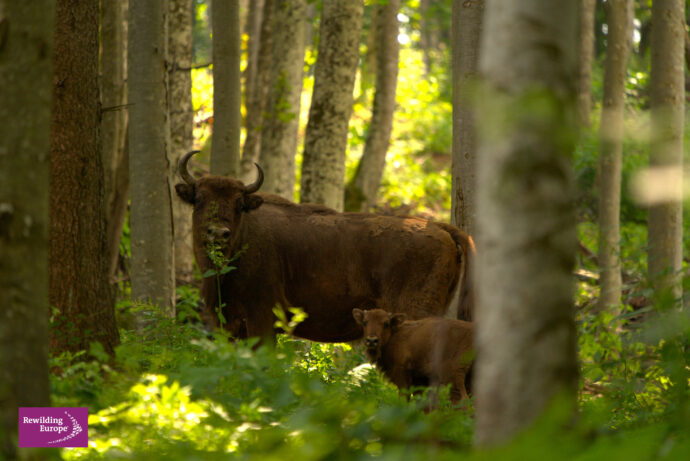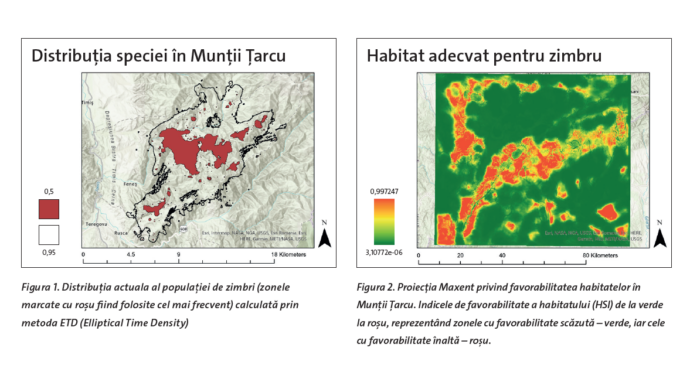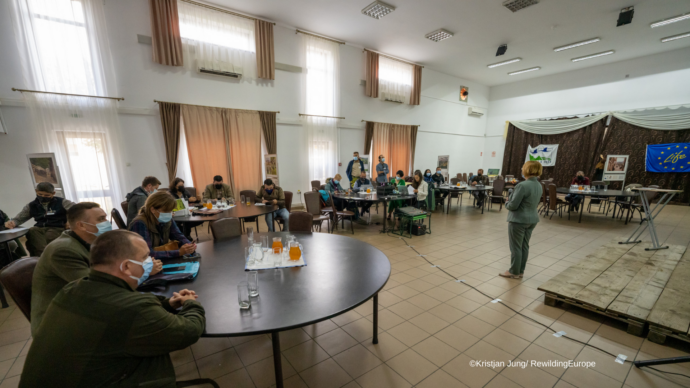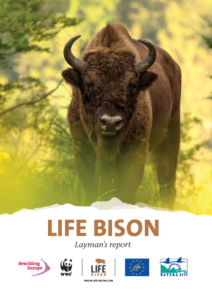Bright future for the European Bison in the Southern Carpathians
After almost 6 years, the project initiated by Rewilding Europe and WWF România to rewild the South-West Carpathians with European bison presents a series of exciting results: the largest free-roaming population of bison in Romania, examples of coexistence and ecotourism. The knowledge gained during the LIFE RE-Bison project is the foundation on which genetically viable populations of bison will develop in the future in the Romanian landscape.
From 2016 until today, 14 transports have been carried out in collaboration with 32 breeding centers and reserves in Europe, which have given the team the chance to gradually improve the process of reintroducing European bison.

“Careful selection of the bison taking into account age, gender and genetic background, group formation before translocation and the correct choice of transporter have contributed to the animals’ adaptability and increased their chances of survival. The calves born in the wild between 2016 and 2021 show us that the habitat is favourable and the species can successfully recover”, says Mariana Drugă, LIFE RE-Bison Project Manager, WWF Romania.
The more than 100 bison in the wild are constantly monitored by WWF rangers in the field and using the newest technology, and so far tracks and other signs of the bisons’ presence have been recorded more than 750 times. 28 individuals have been fitted with collars during the project, allowing them to be tracked by GPS and virtual fences to be set up around fields, hamlets, or orchards that may be in the home range of the bison.
The data collected via GPS collars, together with environmental variables such as altitude, land use, vegetation type, etc. were used to calculate the species’ current home range and the habitat suitability of the reintroduction area in the Țarcu Mountains. According to this analysis the species distribution covers an area of approximately 89 km2, of which 18.4 km2 are intensively used.
Habitat suitability modeling indicated that the species prefers mainly deciduous forests, natural grasslands, and transit areas between them, together with other factors such as water availability and slope of the land.

During the project, a parasitological study was carried out under the coordination of Dr. Andrei Mihalca on the basis of the collaboration protocol between WWF Romania and the University of Agricultural Sciences and Veterinary Medicine Cluj-Napoca (USAMV). A total of 247 samples were collected from bison faeces and 11 types of parasites were identified. DNA analysis by SNP (Single Nucleotide Polymorphisms) genotyping carried out by the Senckenberg Research Institute for Wildlife Genetics in Germany indicates that the Southern Romanian bison reintroduction carries most of the globally available genetic diversity of the European bison Lowland Caucasian lineage.
To maintain harmonious relationships with local communities, over 9 km of electric fencing has been installed and a local intervention team was set up in 2019 to help monitor and proactively intervene to prevent potential human-bison conflicts. Numerous information sessions to better understand the species and the benefits of its return have been conducted throughout the project. According to the sociological survey carried out in 2020, 89% of the people belonging to the Armeniș and Densuș communities consider the European bison to be a beautiful animal and important for the environment.
“Each success has meant a lot of work, in the field, research, many collaborations, and determination to face the challenges of legislative gaps in the reintroduction of the species and post-release management. The closing event of the LIFE RE-Bison project shows us that interest in the project has increased at local and national level, but also that there is a need for a unified strategy that can continue to secure the future of the bison in the Carpathian chain.” Orieta Hulea, Director WWF Romania.

In order to bring all collaborators together and to keep the effort for the conservation of the European bison alive, an event encompassing the results, challenges of the LIFE RE-Bison project and similar initiatives in Romania happened between the 23rd and 24th of September in Armeniș (Caransebeș, RO), and a bison tracking experience in the Bison Hillock. Representatives of the Ministry of Environment, the National Forestry Agency – Romsilva, the National Agency for Protected Natural Areas – Caral-Severin Territorial Service, the Caraș-Severin County Forest Guard, the Sanitary Veterinary and Food Safety Directorate of Reșița, the Teregova Forestry School, and the Municipality of Armeniș, the Vânători Neamț Nature Park, the Porțile de Fier Nature Park, the National Parks: Domogled – Valea Cernei, Semenic, Cheile Nerei – Beusnița, Conservation Carpathia Foundation, USAMV Cluj-Napoca, schools of Armeniș and Teregova and the press.
The LIFE RE-Bison project “Urgent actions for the recovery of European Bison populations in Romania” is implemented by WWF Romania and Rewilding Europe, with financial support from the European Union through the LIFE Programme (LIFE14 NAT/NL/000987).
 Discover the LIFE RE-Bison Layman’s Report and the Good Practice Guide
Discover the LIFE RE-Bison Layman’s Report and the Good Practice Guide
About the project
Once widespread throughout Europe, the European bison were driven to extinction in the early 20th century by over-hunting and habitat loss. As of 2014, Rewilding Europe and WWF-Romania’s ongoing programme for the reintroduction of the bison is the largest attempt of its kind in the Southern Carpathians.
The first two transports took place in 2014 and 2015 in the Tarcu Mountains, in the vicinity of Armeniș commune. The transports were then repeated every year as part of the LIFE RE-Bison project funded by the European Commission. The overall objective of the LIFE Bison project is to establish a demographically and genetically viable wild population of bison in the Southern Carpathians. The sub-populations will be connected by natural corridors, allowing migration and genetic exchange.
Nature as a driving force for the region’s development
The reintroduction of the bison is not the only action undertaken as part of this initiative, although everything is linked and contributes directly or indirectly to this central conservation objective. The bison are the centrepiece of a complex vision in which nature becomes the engine of development for the region and a source of wealth for local communities. This is thanks to the continuous efforts invested in ecotourism, community development, education, research, and technological innovation, for the benefit of nature and people alike.
Nature research and monitoring are key priorities, to measure the impact of the bison on habitats and biodiversity, inform conservation actions, and to better understand and mitigate challenges such as human-wildlife conflict.
In terms of local development, the initiative has encouraged the establishment by local people of an association called AMZA and the WeWilder initiative which are local partners in developing and offering ecotourism services (e.g. accommodation and meals, specialised guides) and local products.
Close collaboration
WWF Romania and Rewilding Europe are working closely with local communities in the rewilding area, involving local entrepreneurs, forestry units, hunting associations, and tour operators, ensuring that the reintroduction programme will achieve all the proposed objectives and will continue in the future.
- To book a bison tracking experience: www.europeansafaricompany.com și www.wewilder.com
- Follow the rewilding action on Facebook Rewilding Southern Carpathians
For more information please contact:
Marina Drugă, Project Manager LIFE-Bison, WWF România, mdruga@wwf.ro +40 729.097.969
Bianca Ștefănuț, Communications Specialist, WWF România, bstefanut@wwf.ro, +40 730.098.722
About WWF (World Wide Fund for Nature)
Founded in 1961, WWF is one of the world’s leading international conservation organisations working in more than 100 countries to stop environmental degradation and build a future where people live in harmony with nature. More details: www.wwf.ro.
About Rewilding Europe
Rewilding Europe was formally established on 28 June 2011 as an independent, non-profit foundation in the Netherlands. Rewilding Europe’s goal is to make Europe a wilder place, with much more space for wildlife and natural values. They invite us to bring biodiversity back to Europe’s wastelands and explore new ways for people to live alongside nature. www.rewildingeurope.com/areas/southern-carpathians